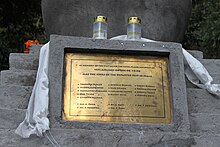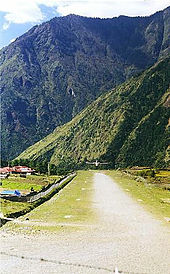Lukla Airport
| Tenzing-Hillary Airport | |
|---|---|

|
|
| Characteristics | |
| ICAO code | VNLK |
| IATA code | LUA |
| Coordinates | |
| Height above MSL | 2846 m (9337 ft ) |
| Basic data | |
| opening | 1964 |
| Start-and runway | |
| 06 (landing only) 24 (takeoff only) |
527 m × 30 m asphalt |
The Lukla Airport ( IATA code : LUA , ICAO code : VNLK , official: Tenzing-Hillary Airport ) in Lukla is an airfield for STOL airplanes in Nepal . It can be reached in a half-hour flight from Kathmandu and today most tourists who travel to the Everest region use it as a starting point, especially for the Mount Everest Trek . Due to its layout, it is considered an Altiport .
history
The runway was built in 1964 by local Sherpas for $ 2,650 under the supervision of Edmund Hillary . It was not until 2001 that the asphalting of the gravel road and the construction of a terminal building and a new tower began . In February 2008 the Nepalese government decided to designate the airport as Tenzing-Hillary Airport after Tenzing Norgay and Edmund Hillary, who died in January 2008 .
Airfield
The flight replaces a one-week journey on foot from Jiri , otherwise the Khumbu region can only be reached by helicopter or plane.
Depending on weather and visibility conditions, the airfield is operated several times a day from Kathmandu. The slope of the 527 m long runway is around 12%, and you can only land uphill and take off downhill. The end of the runway breaks off abruptly about 600 m deep to Dudh Kosi . This fact makes take-offs and landings on this Altiport an experience and the airfield into one of the world's most dangerous places. Although there is only one runway, take-offs and landings in the opposite direction sometimes take place every few minutes, with the aircraft taking off in the Dudh Kosi Valley remaining at a lower altitude and the aircraft that is approaching at the same time at a slight altitude difference encountered in the opposite direction.
With a daily handling of over 50 flights, Lukla is the most frequented domestic airport in Nepal in the high season. The airlines and pilots are under great time pressure during the processing, because on the one hand there are often large traffic jams at Kathmandu Airport and in Lukla with waiting times of several days, on the other hand Lukla often becomes cloudy in the afternoons even with generally good weather due to the mountain and valley wind circulation . If Lukla Airport is closed, the makeshift Phaplu Airport , located about 23 kilometers to the south-west, is used as a stopover, from which, if the weather is clear, you can fly on to Lukla quickly. Phaplu is mostly flown to with a single-engine Pilatus PC-6 . The airlines mainly use the STOL aircraft de Havilland Canada DHC-6 (Twin Otter) and Dornier 228 to fly to Lukla .
Since the accident of October 8, 2008, which was due to poor visibility, the approach has been a little more careful. This in turn meant that in November 2011, for example, around 2500 tourists were stuck in Lukla because of the bad flying weather.
Airlines
Tenzing Hillary Airport is served by the following airlines:
- Nepal Airlines
- Sita Air
- Gorkha Airlines
- Agni Air
- Yeti Airlines (operated by Tara Air )
- Summit Air - formerly Goma Air
Traffic figures
| year | Passenger volume | Freight volume in kilograms |
Flight movements | |||
|---|---|---|---|---|---|---|
| 2003 | 70,959 | - | 1,203,000 | - | 8,616 | - |
| 2004 | 71,422 | + 0.7% | 1,672,606 | + 39.0% | 7,892 | −8.4% |
| 2005 | 53,943 | −24.5% | 1,271,297 | −24.0% | 7,377 | −6.5% |
| 2006 | 61.992 | + 14.9% | 1,771,811 | + 39.4% | 8,800 | + 19.3% |
| 2007 | 80,733 | + 30.2% | 2,445,792 | + 38.0% | 10,969 | + 24.6% |
| 2008 | 92.172 | + 14.1% | 2,739,491 | + 12.0% | 12,219 | + 11.4% |
| 2009 | 88,881 | −3.6% | 2,592,159 | −5.4% | 12,300 | + 0.7% |
| 2010 | 92.011 | + 3.5% | 2,188,763 | −15.6% | 14,880 | + 21.0% |
| 2011 | 93.292 | +1.4% | 2,973,816 | + 35.9% | 15,408 | + 3.5% |
Incidents

- October 15, 1973 - A De Havilland Canada DHC-6 Twin Otter ( aircraft registration 9N-ABG ) of Royal Nepal Airlines was destroyed on landing. The three crew members and three passengers were uninjured.
- June 9, 1991 - A De Havilland Canada DHC-6 "Twin Otter" (9N-ABA) of Royal Nepal Airlines crashed after a flight from Kathmandu on landing in Lukla after an unstable approach under poor weather conditions. All occupants (3 crew members, 14 passengers) survived.
- On September 26, 1992, a Harbin Yunshuji Y-12-II (9N-ACI) of Royal Nepal Airlines with 14 people on board burst the nose wheel tires. The nose landing gear broke, the machine collided with a dam outside the runway, was badly damaged and had to be written off. All occupants (2 crew members, 12 passengers) survived.
- May 25, 2004 - A De Havilland Canada DHC-6 Twin Otter operated by Yeti Airlines (9N-AFD) crashed in thick clouds on the Lamjura Pass west of Lukla while flying from Kathmandu to Lukla. All three crew members were killed; There were no passengers on board.
- On October 1, 2004, the nose landing gear of a Dornier Do 228 operated by Sita Air collapsed at Lukla Airport and the aircraft was badly damaged. It came to a stop at the end of the approximately 530 m long runway. The incident resulted in the airport being closed for two days because the plane had to be recovered. There were neither seriously injured nor dead.
- On June 30, 2005, a Dornier 228-200 of the Nepalese Gorkha Airlines (9N-AEO) got off the runway when landing at Lukla Airport. The aircraft was so badly damaged that it had to be written off. The twelve occupants (nine passengers and three crew members) survived but were slightly injured.
- October 8, 2008 - Yeti Airlines Flight 103 : A De Havilland Canada DHC-6 Twin Otter (9N-AFE) operated by Yeti Airlines crashed with 19 people on board while approaching the airport. According to the authorities, 18 people were killed, only the captain survived the accident.
- October 12, 2010 - A Dornier 228 from Sita Air (9N-AHB) was unable to stop in time due to braking problems and hit a wall at the end of the runway. The nose of the machine was badly damaged. The 11 passengers and 3 crew members were uninjured. The same plane crashed on June 1, 2013 while landing in Simikot .
- On May 27, 2017 there was an unsuccessful attempt to land a Let L-410 (9N-AKY) cargo aircraft of the Nepalese Summit Air with three people on board at Lukla Airport. Due to a stall , the machine collided with trees and crashed into a mound in the sloping terrain shortly before the runway. The captain and co-pilot were fatally injured and the third person survived the accident. The cargo flight had started in Kathmandu .
- On April 14, 2019, a LET L-410 of the airline Summit Air (9N-AMH) came off the runway while taking off and crashed into two helicopters. These parked about 30 to 50 meters from the runway. The co-pilot of the aircraft and a police officer stationed at the airport died at the scene of the accident, another police officer died shortly afterwards in the Kathmandu hospital .
Anecdotes
It is said that Edmund Hillary was dissatisfied with the strength of the soil when the original airstrip was built. He then got all of his Sherpas to perform a two-day festival dance on the premises. Afterwards, the dancers' stamping made the ground firm enough.
Web links
- Start from Lukla Airport (YouTube film)
- Start from Lukla Airport (YouTube film)
- Take-off and landing from the pilot's point of view (YouTube film)
- Landing from the pilot's point of view (YouTube film)
Individual evidence
- ↑ a b Nepal renames airport after Everest pioneers. In: thedailystar.net . February 12, 2008, accessed February 23, 2020 .
- ↑ a b Everest pioneers will be remembered. In: iol.co.za. Independent Online, February 11, 2008, accessed February 23, 2020 .
- ↑ see information from www.gcmap.com.
- ↑ Cynthia Drescher: This Is the World's Most Dangerous Airport. Condé Nast Traveler, April 12, 2016, accessed March 8, 2020 .
- ↑ Take a deep breath at the world's most dangerous airport. In: Bild.de . November 7, 2011, accessed December 21, 2014 .
- ↑ Civil Aviation Report 2011-2012 ( Memento of the original from March 6, 2016 in the Internet Archive ) Info: The archive link was inserted automatically and has not yet been checked. Please check the original and archive link according to the instructions and then remove this notice. (PDF; 7.6 MB), p. 47.
- ^ Accident report DHC-6 9N-ABG , Aviation Safety Network (English), accessed on December 14, 2018.
- ^ Accident report DHC-6 9N-ABA , Aviation Safety Network (English), accessed on December 14, 2018.
- ^ Accident report Harbin Y-12 II 9N-ACI , Aviation Safety Network (English), accessed on December 14, 2018.
- ^ Accident report DHC-6 9N-AFD , Aviation Safety Network (English), accessed on December 14, 2018.
- ^ Sita Air Dornier blocks Lukla runway in Aviation Safety Network (English), accessed October 1, 2004.
- ^ Accident report Do 228-200 9N-AEO , Aviation Safety Network (English), accessed on December 15, 2018.
- ^ Accident report DHC-6 9N-AFE , Aviation Safety Network (English), accessed on December 14, 2018.
- ↑ Twelve Germans die in a plane crash in Nepal. In: Spiegel Online . October 8, 2008, accessed December 21, 2014 .
- ↑ Press release of the airline with passenger list
- ^ Accident report Do 228 9N-AHB , Aviation Safety Network (English), accessed on May 28, 2017.
- ↑ Accident report LET L-410 9N-AKY May 27, 2017 in The Aviation Herald (engl.)
- ^ Accident report LET L-410 9N-AKY , Aviation Safety Network (English), accessed on May 28, 2017.
- ↑ Crashed in a helicopter: three dead after the accident of a Let L-410 in Lukla. In: aeroTELEGRAPH. April 14, 2019, accessed on April 14, 2019 (German).
- ^ Accident report LET L-410 9N-AMH , Aviation Safety Network (English), accessed on October 16, 2019.
- ↑ At least three killed in Summit Air plane crash at Lukla airport. Accessed April 14, 2019 .
- ↑ Three dead in a plane crash on Mount Everest. Retrieved April 14, 2019 .
- ↑ http://www.trevorstravels.com/landing-at-lukla-airport-nepal/



